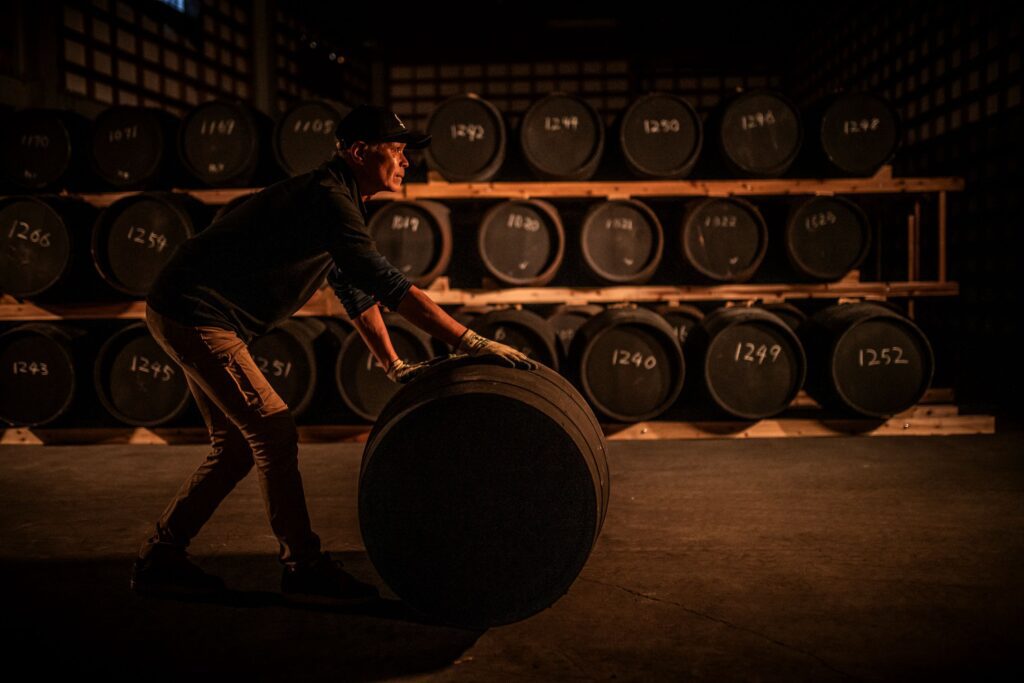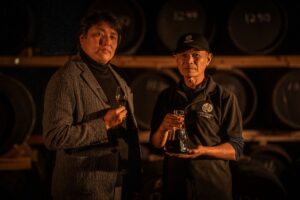
Q&A with Karuizawa’s Master Distiller, Yoshiyuki Nakazato
Founded in 1955 in Miyota, Japan, a small town with a humid continental climate located on the foothills of Mount Asama in the Nagano Prefecture, Karuizawa Distillery was known for its creative and high-quality small-batch sherry-cask releases. After closing in 2000, Karuizawa vintages were highly sought after, evidenced by the bottles sold on whisky market places and auctions for exorbitant prices.
Now based in their namesake town Karuizawa, just a twenty minute drive from the original distillery, the revived and renamed Karuizawa Whisky Company, in partnership with Dekantā, are keen to embody the original distillery’s core values and bring their meticulous principles into whisky making. This includes using the same people, recipes and even equipment as the two pot stills made by Forsyths are originals.
We asked Master Distiller, Yoshiyuki Nakazato, who worked had worked under the Master Distiller at the original distillery, and Founder and CEO, Shigeru Totsuka about their background and vision of the Karuizawa legacy.
Hi Nakazato-san. Thank you for agreeing to interview. Could you start by telling us your background and how you found yourself involved in the whisky industry?
Nakazato-san, Master Distiller: I worked at the original Karuizawa Distillery as the apprentice to the Master Distiller and my close friend, Osami Uchibori. Uchibori-san taught me a lot about how to make good whisky, and I soaked up as much information as I could from him.
Once the original distillery closed, I took a short time out of whisky, working in the wine industry, before returning to Karuizawa to help Totsuka-san reopen this legendary distillery. Uchibori-san, who then became an official advisor to Totsuka-san, told me that I was his most trusted apprentice and recommended that I should be the Master Distiller at the new Karuizawa Whisky Distillery.
What do you want people to know to know about the new Karuizawa distillery. What connections are left to the old distillery and what innovations have been made?
NS: The first thing is that at the new distillery we are aiming to produce whisky that honours the rich legacy that the Karuizawa Whisky names carries with it. We are acutely aware of the standard set by the old liquid and so we want to work tirelessly to produce a liquid that actually surpasses that of the old Karuizawa.
To do that we have taken steps to ensure we do things in the same way, as much as possible. From having our stills custom made in the same style as the old stills, with the same unique attributes such as the flat bottom and angled line arm, to using top quality sherry casks for maturation. We have even laid the inside of the distillery out in the same way as the old Karuizawa.
We do all of our work manually, with no automation, so everything is done by touch, feel and taste, as it was in the old days.
In terms of connections to the old distillery, it is basically related to human resources as there is no capital relationship at all between the old Karuizawa Whisky and the new one. We had Uchibori-san, the previous Master Distiller, as an official advisor to the new distillery until he sadly passed away, and I also worked under Uchibori-san at the old distillery and now works as a master distiller – there are still old & rare bottles out there with my signature on them.
We also operate in the Mount Asama climate, despite moving from Miyota to Karuizawa, resulting in a low angels’ share and we utilize the same water source from Mt. Asama.
What can you tell us about the whisky Karuizawa Whisky is distilling?
NS: We are distilling a rich, sherried whisky that will deliver fruity and oaky tasting notes on the nose and palate. We have designed our new make spirit specifically for sherry cask maturation, ensuring it draws a lot of influence from the cask while still showcasing the subtle sweet tones of the new make spirit.
Our new make is well rounded and very smooth and I think it’s of a very high quality. Many whisky enthusiasts that have visited have been impressed with the liquid that comes straight off the still and that combined with high quality sherry maturation puts us in a good place to deliver an exciting, delicious product.

Karuizawa Whisky Company Founder & CEO Shigeru Totsuka with Master Distiller Yoshiyuki Nakazato.
What challenges have you faced in re-establishing a closed distillery?
Totsuka-san, Founder and CEO: The main challenges were around finding the right place for the distillery and the right people. The original Karuizawa Distillery was actually in a neighbouring town – Miyota – but I was determined to build the new distillery in Karuizawa itself. We scouted many locations, needing a place that had enough land for the distillery but also for our planned visitor centre and maturation warehouses. This took some time and at times was frustrating, but we got there in the end.
On the personnel, I was aware that in order to create a whisky as good as the old Karuizawa, I would need people with a true understanding of how that was achieved and how it could be achieved again. Fortunately, I was introduced to the legendary Uchibori-san by a friend and he offered me lots of brilliant advice, as well as introducing me to his most trusted apprentice and distiller – Nakazato-san – who has been essential to the getting things off the ground and creating such a fantastic new make spirit.
What should people know about Japanese whisky? How does it defer from other whiskies on the market? What do you love about it?
NS: The Japanese whisky market is relatively young and small at the moment, although it is growing quickly. Everyone in the industry acts as a community, looking to help each other and raise the industry as a whole and this part of it is something that I love.
I think another difference that I am aware of is that in Japan, craftspeople always strive for perfection, meaning that sometimes things can take a little longer than they do elsewhere. But good whisky making takes time and I think that’s reflected in the number of awards Japanese whiskies have won in recent years.
What is the whisky market/industry like in Japan vs Scotland?
TS: The Japanese whisky market is much smaller and younger than that of Scotland. For years, it was dominated by just 3 or 4 distilleries, mainly owned by Nikka and Suntory, but in recent times it has grown dramatically and there are now over 100 distilleries in Japan, however most of them have a very small output, less than 1,000 casks in an annual production including ourselves.
What’s more, while Scotland has a very broad whisky landscape, with hundreds of distilleries across the different regions, most of them are owned by a select few large companies, with only a small number of independent distilleries remaining.
Japan is quite different in this regard as most of the new distilleries popping up around the country are independently owned and run – in many cases they are family businesses.
I think in the future we will see more variety in the Japanese whisky industry, as we do in Scotland, but there will always be subtle differences in the way the two industries operate.
What is a typical day life in the life of a distiller?
NS: Each day, we carefully adhere to our scheduled processes – malt crushing, drawing, fermentation, and distilling – while closely monitoring the effects of the rising temperatures within our factory during the summer months.
In this season, I place particular emphasis on managing the factory’s temperature, as it can significantly impact the fermentation process. By attentively overseeing these conditions, we ensure that each stage of production is optimized, even as the heat of summer presents its challenges.
What was your first dram? Can you share your memory of it?
NS: That must have been quite some time ago. While I do struggle to recall the exact distillery, it was definitely a Japanese whisky I believe. Since dedicating my career to whisky-making, I generally indulge in only modest amounts of alcohol while steering clear of stimulant foods to keep my focus on the art of whisky-making. This approach, while personal, cultivates a heightened sensitivity to taste and aroma, which I believe indirectly contributes to the exceptional quality of the whisky we produce. By immersing myself fully in the craft, I ensure that every detail of our whisky reflects the highest standards of excellence.
Do you have any unpopular opinions about whisky?
NS: Articulating the essence of Japanese whisky can be challenging, but I believe it’s clear that Japanese whisky carves out its own distinct path and sets itself apart from the other four whisky-producing regions around the world. At the end of the day, we recognize that the true measure of this uniqueness lies in the hands of the connoisseurs who savour it.
That’s why we are dedicated to refining our production techniques every day, even if only by a small increment, harnessing the advantages of our natural climate. Our commitment is to continually enhance our craft, ensuring that every bottle reflects the exceptional quality and distinctive character of Japanese whisky.
What do you want people to know about distilling?
NS: What I hope people understand most is the profound care and dedication we bring to our craft here in Japan. We are committed to perfecting every detail and honouring the legacy of those who came before us, all while elevating the industry by releasing only the finest products.
Our passion extends beyond the taste of the whisky; it encompasses the entire journey of its creation. For me, the joy lies not only in the final product but in the meticulous process of crafting it – it’s all part of the whisky experience.
TAGS

